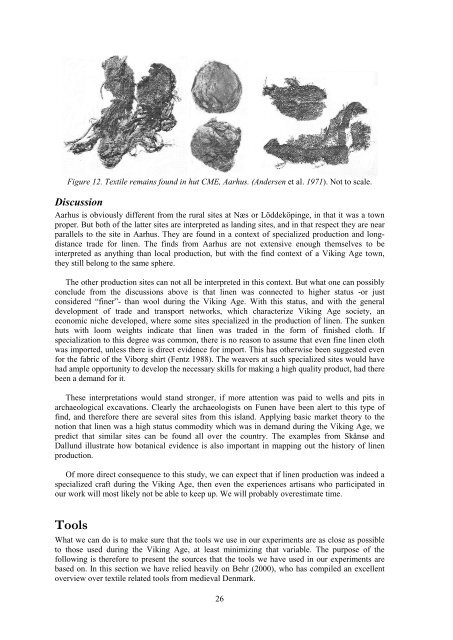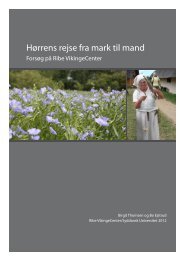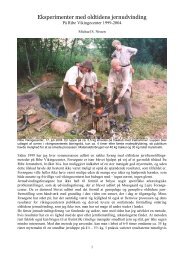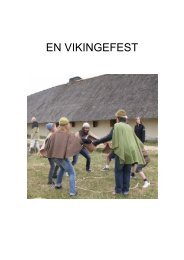From flax to linen. Experiments with flax - Ribe VikingeCenter
From flax to linen. Experiments with flax - Ribe VikingeCenter
From flax to linen. Experiments with flax - Ribe VikingeCenter
Create successful ePaper yourself
Turn your PDF publications into a flip-book with our unique Google optimized e-Paper software.
Figure 12. Textile remains found in hut CME, Aarhus. (Andersen et al. 1971). Not <strong>to</strong> scale.<br />
Discussion<br />
Aarhus is obviously different from the rural sites at Næs or Löddeköpinge, in that it was a <strong>to</strong>wn<br />
proper. But both of the latter sites are interpreted as landing sites, and in that respect they are near<br />
parallels <strong>to</strong> the site in Aarhus. They are found in a context of specialized production and longdistance<br />
trade for <strong>linen</strong>. The finds from Aarhus are not extensive enough themselves <strong>to</strong> be<br />
interpreted as anything than local production, but <strong>with</strong> the find context of a Viking Age <strong>to</strong>wn,<br />
they still belong <strong>to</strong> the same sphere.<br />
The other production sites can not all be interpreted in this context. But what one can possibly<br />
conclude from the discussions above is that <strong>linen</strong> was connected <strong>to</strong> higher status -or just<br />
considered “finer”- than wool during the Viking Age. With this status, and <strong>with</strong> the general<br />
development of trade and transport networks, which characterize Viking Age society, an<br />
economic niche developed, where some sites specialized in the production of <strong>linen</strong>. The sunken<br />
huts <strong>with</strong> loom weights indicate that <strong>linen</strong> was traded in the form of finished cloth. If<br />
specialization <strong>to</strong> this degree was common, there is no reason <strong>to</strong> assume that even fine <strong>linen</strong> cloth<br />
was imported, unless there is direct evidence for import. This has otherwise been suggested even<br />
for the fabric of the Viborg shirt (Fentz 1988). The weavers at such specialized sites would have<br />
had ample opportunity <strong>to</strong> develop the necessary skills for making a high quality product, had there<br />
been a demand for it.<br />
These interpretations would stand stronger, if more attention was paid <strong>to</strong> wells and pits in<br />
archaeological excavations. Clearly the archaeologists on Funen have been alert <strong>to</strong> this type of<br />
find, and therefore there are several sites from this island. Applying basic market theory <strong>to</strong> the<br />
notion that <strong>linen</strong> was a high status commodity which was in demand during the Viking Age, we<br />
predict that similar sites can be found all over the country. The examples from Skånsø and<br />
Dallund illustrate how botanical evidence is also important in mapping out the his<strong>to</strong>ry of <strong>linen</strong><br />
production.<br />
Of more direct consequence <strong>to</strong> this study, we can expect that if <strong>linen</strong> production was indeed a<br />
specialized craft during the Viking Age, then even the experiences artisans who participated in<br />
our work will most likely not be able <strong>to</strong> keep up. We will probably overestimate time.<br />
Tools<br />
What we can do is <strong>to</strong> make sure that the <strong>to</strong>ols we use in our experiments are as close as possible<br />
<strong>to</strong> those used during the Viking Age, at least minimizing that variable. The purpose of the<br />
following is therefore <strong>to</strong> present the sources that the <strong>to</strong>ols we have used in our experiments are<br />
based on. In this section we have relied heavily on Behr (2000), who has compiled an excellent<br />
overview over textile related <strong>to</strong>ols from medieval Denmark.<br />
26






